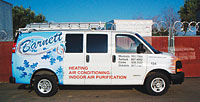The current outlook for the upcoming winter (October 2005 through March 2006) is bleak, with expected heating fuel expenditure increases of 69 percent to 77 percent for natural gas in the Midwest; 17 percent to 18 percent for electricity in the South; 29 percent to 33 percent for heating oil in the Northeast; and 39 percent to 43 percent for propane in the Midwest.
EIA noted that expenditure increases for natural gas are anticipated to be particularly strong in the East North Central region (Ohio, Indiana, Illinois, Michigan, and Wisconsin) because of expected higher heating-related demand in comparison to the relatively mild conditions seen last year.
These higher fuel costs are definitely not good news for the consumer, who will be in for a nasty surprise when the first utility bills arrive this winter. This is a good time, though, for contractors to talk with customers about the benefits of high-efficiency furnaces.

High Efficiency Always Makes Sense
When energy costs are lower, it is sometimes difficult to convince the customer to part with an extra $500 or $600 to move into the 90 percent-plus efficient range of furnaces. The much higher price of fuel this winter will make that almost a moot point, as the savings should pay for the difference in initial cost in just a few years. The bottom line is that a high-efficiency furnace can save money by reducing the expense of heating a home.Ed Billy, general manager, Barnett Inc., Riverbank, Calif., noted that even in his relatively temperate climate, "We're seeing a big demand for high-efficiency furnaces. We show the customer what they're going to pay per hour and per year to run their system compared to a new 90 percent-efficient system. Then we do a 10-year analysis and normally with what they're overpaying utility companies, it's just a no-brainer, they don't think twice about going with a 90 percent furnace."
Billy stated that almost all his customers opt for a 90 percent-efficient (or higher) furnace - usually a York Affinity system - and he prefers it that way for several reasons.
First, higher-efficiency furnaces will save customers money on their utility bills while providing more comfort. Second, they take less time to install.
"Our guys are really good at installing 90 percent furnaces. They're faster at installing 90 percent furnaces than 80 percent furnaces. With all the sheet metal, flues, twists and turns, the ABS piping off the 90 percent is really fast."

"We've always been that way," said McIver. "We were putting in spark ignition furnaces back in the early 80s when everybody else was just putting in standing pilots. From an efficiency standpoint, we've always been about how can we save our customers a few dollars in operating costs and get them a better system."
Quality is McIver's No. 1 concern, and he doesn't necessarily believe in presenting the customer with the typical good, better, best scenario.
He considers the single-stage single-speed 90 percent furnace as the starting point, then customers can opt for more "bells and whistles" such as variable speed if they'd like. When selling a two-stage furnace, McIver's preference is to sell a variable-speed two-stage furnace.
"We focus on giving customers a good quality heating and cooling system. I want customers to buy what they really need from an efficiency and quality standpoint. If there's any money left over, we can make the next jump or add a few accessories. My prime concern, though, is to get them into that higher efficiency, because it'll save them on operating costs," McIver said.

Educating Consumers
While homeowners are definitely concerned about saving money on their energy bills, they are in desperate need of information when it comes to choosing a furnace."Typically, they don't know anything," said Billy. "They don't know about brands, ratings, variable speed, or two stage. We have to educate them every single time."
That can be harder than it sounds because customers might already be confused if they've received bids from other contractors. Billy noted that they try to keep things as simple as possible by asking the customer questions about their particular living circumstances. "Once they answer our detailed questions, we can be sure we're designing the right system for them."
Right now, the biggest concern for most customers is how much money a new furnace can save them. As McIver stated, "The bulk of the market wants to pay a reasonable price for a comfortable system that will save them money on their operating costs. Even when you're working in the upper-end market, which is where we are, people mainly want a good quality furnace that will last them more than 10 years and save them some money on their energy bills."
While customers are definitely confused about the various furnace options available, McIver said that contractors can help the decision-making process by putting a lot of the information on their Web sites. Those shopping on the Loesch Heating and Air Conditioning Web site can research the various products available, as well as find out about financing options.
"Customers are much savvier than they used to be," noted McIver. "We have to do everything we can to not only differentiate ourselves from the other guys, but we have to help educate that consumer. Consumers are trying to grasp all the things that are out there, and we have to do everything we can to help them make the right decision."
And for most homeowners around the country, the best decision may just be to install a highly efficient furnace before the snow flies - and the fuel prices increase - this winter.
Publication date: 11/21/2005




